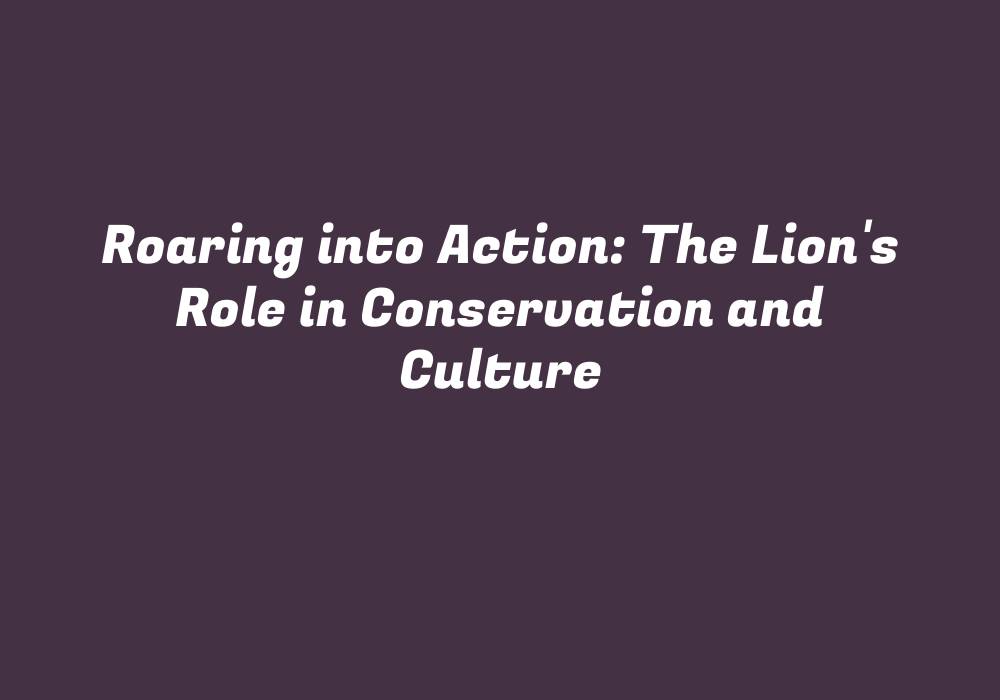Introduction: The Lion’s Roar Echoes through Conservation and Culture
The lion, known for its immense strength and regal presence, has been a part of our culture for centuries. It is an iconic symbol representing power, pride, and wisdom in numerous civilizations across the world. However, while we admire their majesty through stories, paintings, and even movies, these magnificent creatures have been facing a slow yet steady decline in their natural habitats.
Conservation: The Need for Action
Lions are listed as vulnerable on the IUCN Red List of Threatened Species due to various factors such as habitat loss, poaching, and human-wildlife conflicts. These beautiful felines are estimated to have declined by 43% in their African ranges over the past two decades. Conservation efforts, both on a national and international scale, need to be intensified if we are to preserve this iconic species.
African Wildlife Foundation: Leading the Charge
The African Wildlife Foundation (AWF) has been working diligently on lion conservation for many years. They have successfully implemented various initiatives such as community engagement programs and habitat restoration projects, which aim to protect this iconic species while also improving the well-being of local communities. By partnering with rural populations in Africa, the AWF helps minimize human-wildlife conflicts, promotes coexistence between humans and lions, and encourages conservation practices through education.
Tourism: A Double-Edged Sword
Tourism can either be a significant contributor to the preservation of endangered species or a catalyst for their destruction. In the case of lions, tourism has provided opportunities for people to observe these animals in their natural environment and appreciate their beauty. However, unregulated or poorly managed tourism practices could lead to habitat degradation, disruption of wildlife behaviors, and ultimately pose a threat to the lion population.
Conservation through Education
Educating people about the importance of lion conservation and its role in maintaining ecosystem balance is essential for creating awareness about this issue. Organizations like Lion Guardians, working in Kenya and Tanzania, aim to train local community members to become wildlife monitors who can protect lions and other wildlife from threats while promoting sustainable livelihoods within their communities.
Lion-Inspired Art: Preserving Cultural Heritage
The lion is a symbol of power and pride in numerous cultures across the globe. Its representation has influenced various forms of art, from ancient rock paintings to modern masterpieces. By preserving this rich cultural heritage through artwork, we can help keep these endangered animals relevant and meaningful in people’s lives.
Conclusion: Embracing Lion Conservation as a Global Responsibility
In conclusion, the lion is a vital part of our planet’s rich biodiversity and cultural heritage. As we face the challenges posed by habitat loss, poaching, and human-wildlife conflicts, it is time to take action in preserving this iconic species. Through various conservation efforts, education initiatives, and community engagement programs, we can work towards a more sustainable future that balances the needs of both people and wildlife. As we continue roaring into action for lion conservation, let’s embrace our role as stewards of this magnificent creature and its role in preserving our shared global heritage.
Lion Conservation Resources and Related Articles
- Conservation Strategies for Lions at African Wildlife Foundation
- Saving Africa’s Lions: An Urgent Priority
- The Lives of Lions in Kenya are Changing
- Can the Future of Africa’s Wildlife Be Saved?
- Lion Guardians: Preserving Lions and Empowering Communities in Kenya and Tanzania
- World Wildlife Foundation’s Lion Conservation Page
- Why These Lions are Roaring into Action for Endangered Species
- Lioness: The Fierce Life of a Killing Machine
- Why Lions Matter Beyond Their Own Survival: The Big Cats’ Role in Ecosystems and Our Lives
- Culture and Lion Iconography at the Louvre Museum
This article serves as a call to action, emphasizing the importance of lion conservation not only for the sake of these magnificent animals but also to preserve our shared cultural heritage. By actively participating in initiatives aimed at protecting lions and their habitats, we can ensure that the roar of the lion continues to echo through the savannas for generations to come.
